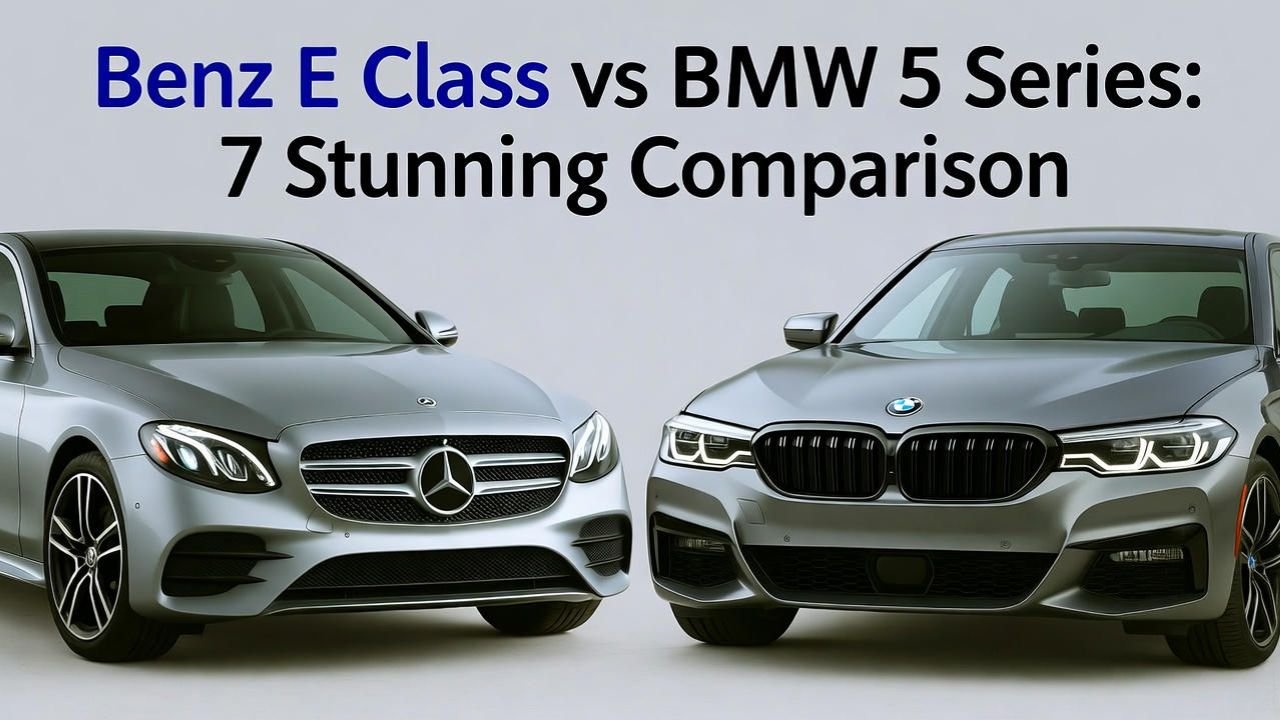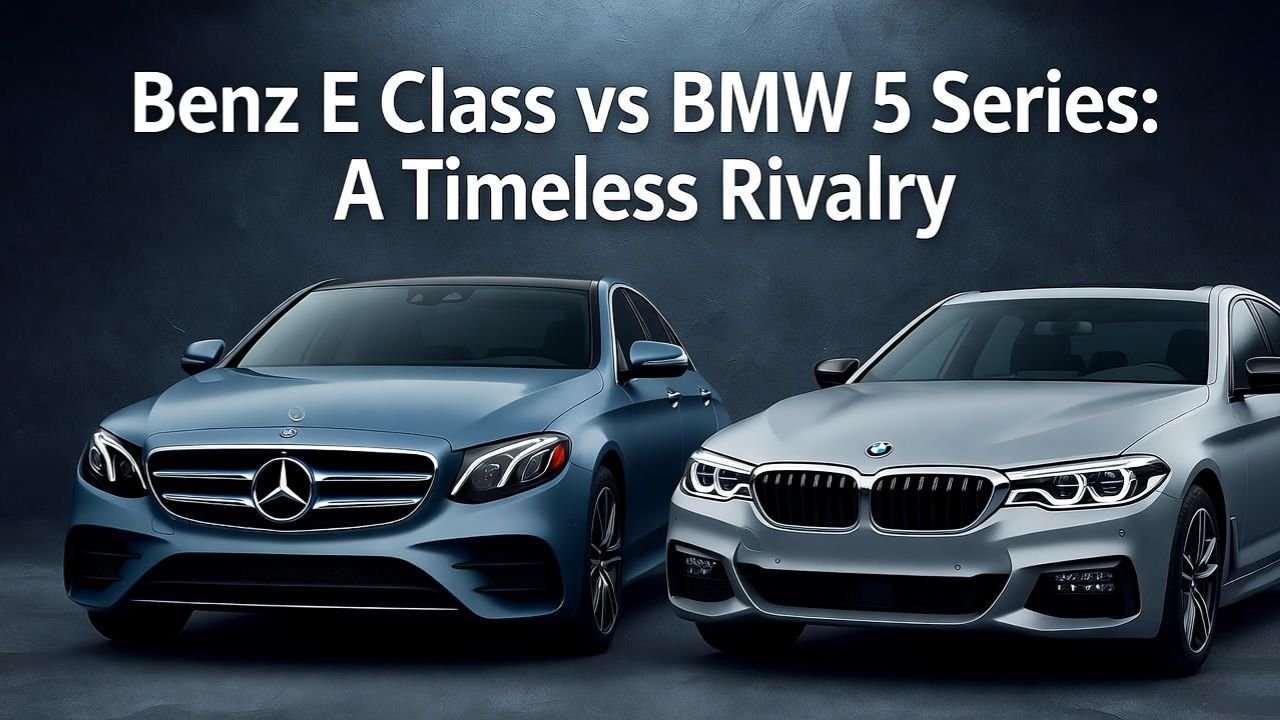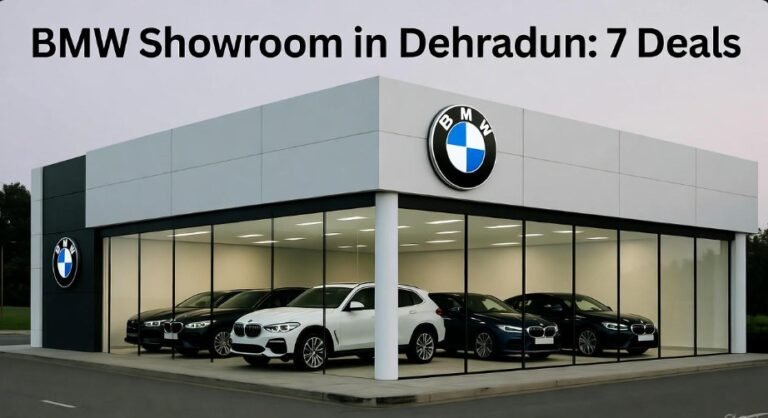Benz E Class vs BMW 5 Series: 7 Stunning Comparison

The Benz E Class vs BMW 5 Series: 7 Stunning Comparison reveals luxury sedan rivals excel differently. The E-Class offers supreme comfort and tech, while the 5 Series prioritizes driving dynamics and sportiness. Your choice depends on whether you seek opulent cruising or engaging performance.
Key Takeaways
- Compare luxury sedan styles.
- Discover E-Class’s comfort and tech.
- Explore 5 Series’ sporty driving.
- Analyze performance and engines.
- Evaluate interior design and features.
- Understand advanced technology.
- Consider price and value differences.
Navigating the world of luxury sedans can feel a bit overwhelming, especially when two giants like the Mercedes-Benz E-Class and the BMW 5 Series are in play. You might be wondering which one truly stands out for your needs. These cars are often compared because they represent the pinnacle of German engineering in the mid-size luxury segment. They offer a blend of performance, comfort, and cutting-edge technology that appeals to a wide range of drivers across the USA. We’re here to break down the nuances of the Benz E Class vs BMW 5 Series: 7 Stunning Comparison, making it simple for you to decide. Get ready to explore what makes each of these automotive icons exceptional.
Benz E Class vs BMW 5 Series: A Timeless Rivalry

For decades, the Mercedes-Benz E-Class and the BMW 5 Series have been locked in a battle for supremacy in the executive sedan market. These aren’t just cars; they are statements of success, technological prowess, and refined taste. In the USA, these vehicles are not only popular choices for discerning car buyers but also frequently seen in executive fleets and as aspirational vehicles for many. Understanding their differences is key to making an informed decision. While both offer premium experiences, they cater to slightly different priorities. The Mercedes-Benz E-Class is often lauded for its serene ride, opulent interior, and advanced comfort features, making it a sanctuary on wheels. The BMW 5 Series, on the other hand, has built its reputation on delivering a more engaging and sporty driving experience, often described as the “ultimate driving machine” in its class. This comparison will delve into seven key areas where these two titans either shine individually or engage in a closely fought contest.
1. Design Philosophy: Elegance Meets Athleticism
The exterior design of a car is its first impression, and both the E-Class and the 5 Series make strong, albeit different, statements. Mercedes-Benz typically opts for a design language that emphasizes elegance and flowing lines. The E-Class embodies this with its sophisticated grille, smooth body panels, and a stately presence that suggests luxury and refinement. It’s a design that ages gracefully and appeals to those who appreciate timeless style. Think of it as a perfectly tailored suit – classic, sophisticated, and always appropriate. On the other hand, BMW’s design philosophy leans towards athleticism and dynamic presence. The 5 Series often features sharper lines, a more aggressive stance, and the iconic kidney grille that signifies its sporty heritage. It conveys a sense of performance and dynamism, appealing to drivers who want their car to look as engaging to drive as it actually is. It’s more akin to a well-fitted athletic outfit – designed for performance and to turn heads with its sharp, purposeful design. Both are undeniably premium, but the choice between them comes down to whether you prefer understated luxury or assertive sportiness.
2. Interior Comfort and Luxury: A Tale of Two Sanctuaries
Step inside, and the differences in design philosophy become even more apparent. The Mercedes-Benz E-Class is renowned for its exceptionally comfortable and luxurious cabin. Mercedes-Benz excels at creating an environment that feels both opulent and relaxing. Expect plush seating, high-quality materials like fine wood trims and soft leather, and ambient lighting that can transform the mood of the cabin. The ride quality is typically smoother, isolating occupants from road imperfections, making it ideal for long journeys or navigating bustling city traffic in places like Los Angeles or New York. The technology integration in the E-Class is also designed to be intuitive and user-friendly, focusing on enhancing comfort and convenience. For instance, the MBUX (Mercedes-Benz User Experience) infotainment system is known for its natural voice control and impressive digital displays. You can learn more about Mercedes-Benz’s commitment to interior innovation on their official website.
The BMW 5 Series also offers a premium interior, but its focus is subtly different. While still luxurious, the 5 Series cabin often feels more driver-centric. The ergonomics are designed for ease of use by the person behind the wheel, with controls logically placed and readily accessible. The materials are undoubtedly top-tier, with excellent fit and finish, but the overall ambiance might lean more towards modern sportiness than outright opulence. The seats in the 5 Series are often designed to provide excellent support during spirited driving, and the driving position is typically more commanding. BMW’s iDrive infotainment system is highly regarded for its functionality and responsiveness, offering a wealth of features for connectivity and entertainment, often controlled via a central rotary dial or touchscreen. While both offer exquisite interiors, the E-Class prioritizes a serene, classic luxury experience, while the 5 Series emphasizes a sophisticated, driver-focused environment with a modern edge.
3. Driving Dynamics: Comfort vs. Engagement
This is perhaps the most significant differentiator between the Benz E Class and the BMW 5 Series. Mercedes-Benz has historically tuned the E-Class for supreme comfort and a smooth, refined ride. The suspension is designed to absorb bumps and road imperfections, providing a serene experience for passengers. When you drive an E-Class, you feel insulated from the outside world, allowing for relaxed cruising, especially on highways across the vast American landscape. Steering is precise but often lighter, prioritizing ease of use over raw feedback. It’s a car that makes you feel serene and in control, effortlessly gliding down the road.
BMW, with its “ultimate driving machine” mantra, engineers the 5 Series to offer a more engaging and dynamic driving experience. The suspension is typically firmer, providing better road feel and reducing body roll during cornering. The steering is often more direct and communicative, allowing the driver to feel more connected to the road and the car’s behavior. This translates into a vehicle that is more exhilarating to drive, particularly on twisty roads or during spirited driving. While the ride is still comfortable for a luxury sedan, it prioritizes agility and responsiveness. Drivers who enjoy the act of driving and want a car that feels lively and agile will likely gravitate towards the 5 Series. For a deeper dive into BMW’s driving dynamics philosophy, explore their official technology pages.
4. Performance and Powertrain Options: Power for Every Need
Both the E-Class and the 5 Series offer a range of potent engines, from efficient four-cylinders to powerful V8s, and increasingly, sophisticated hybrid and electric variants. The choice of powertrain significantly impacts the driving experience and fuel economy, which are crucial considerations for drivers in the USA due to varying gas prices and environmental consciousness.
The Mercedes-Benz E-Class offers powertrains that are generally tuned for smooth, effortless acceleration. Even the base engines provide ample power for confident overtakes and highway cruising. Higher trims, such as the AMG E63 S, offer extraordinary performance, but the core E-Class experience emphasizes refined power delivery. Mercedes-Benz is also at the forefront of integrating mild-hybrid technology (like the EQ Boost) into its gasoline engines, which smooths out acceleration and can improve efficiency.
BMW’s 5 Series also boasts impressive engine options. Its inline-six engines are particularly smooth and powerful, and the M Sport versions offer truly exhilarating performance. BMW’s xDrive all-wheel-drive system is widely available and highly regarded for its ability to enhance traction and stability in various conditions, a valuable feature for drivers in regions with challenging weather. The 5 Series often feels a bit more responsive directly off the line, and the gearshifts might feel quicker and more direct, complementing its sportier character.
Here’s a look at typical powertrain offerings, noting that exact specifications can vary by model year and trim:
| Feature | Mercedes-Benz E-Class (Typical) | BMW 5 Series (Typical) |
|---|---|---|
| Base Engine | 2.0L Turbocharged 4-Cylinder (RWD/AWD) | 2.0L Turbocharged 4-Cylinder (RWD/AWD) |
| Mid-Range Engine | 3.0L Turbocharged Inline-6 with Mild-Hybrid (AWD) | 3.0L Turbocharged Inline-6 (RWD/AWD) |
| Performance Variants | AMG E53, AMG E63 S (V8) | M550i (V8), M5 (V8) |
| Key Characteristics | Smooth, refined power delivery, emphasis on comfort. | Responsive, engaging power delivery, sporty feel. |
| Hybrid/Electric Options | EQ Boost mild-hybrid, Plug-in Hybrid variants available. | Plug-in Hybrid variants (e.g., 530e), and fully electric i5 model. |
5. Technology and Infotainment: Innovation at Your Fingertips
In the modern automotive landscape, technology is a huge selling point, and both Mercedes-Benz and BMW pack their flagship sedans with advanced systems. The E-Class often leads with its MBUX infotainment system, which is celebrated for its large, visually stunning dual screens that can dominate the dashboard. These screens house everything from navigation and media to climate control and vehicle settings. The system recognizes natural language commands, so you can simply say, “Hey Mercedes, I’m cold,” and it will adjust the temperature. The integration of advanced driver-assistance systems (ADAS) is also a hallmark of the E-Class, offering features like adaptive cruise control, lane-keeping assist, and semi-autonomous driving capabilities on certain highways, enhancing safety and reducing driver fatigue.
BMW’s iDrive system is a formidable competitor, known for its logical menu structure, sharp graphics, and ease of use, often via a combination of touchscreen, voice commands, and the intuitive rotary controller on the center console. BMW’s approach to technology often feels more driver-focused, providing quick access to performance-related information and settings. The BMW Intelligent Personal Assistant offers similar voice control capabilities to Mercedes’ MBUX. Both brands offer advanced connectivity features, including smartphone integration (Apple CarPlay and Android Auto), advanced navigation, and premium audio systems. For those interested in the cutting edge of automotive technology and safety features, the National Highway Traffic Safety Administration (NHTSA) provides valuable safety ratings and information on ADAS features. Both cars offer a futuristic experience, but the E-Class might feel slightly more avant-garde with its expansive displays, while the 5 Series offers a highly functional and refined tech suite.
6. Practicality and Space: Everyday Usability
When considering a luxury sedan, especially for families or those who regularly carry passengers and cargo, practicality is key. The E-Class and 5 Series both offer ample passenger space in the front and rear seats, making them comfortable for adults on longer journeys. Legroom and headroom are generally generous in both vehicles, although minor differences might exist depending on the specific body style (sedan vs. wagon, if available).
In terms of cargo space, the trunk in both the E-Class and the 5 Series sedans is typically substantial enough for regular use, accommodating groceries, luggage for a weekend getaway, or golf clubs. For those needing more versatility, both manufacturers often offer wagon variants (like the E-Class All-Terrain or the 5 Series Touring, though the latter is less common in the US market) that provide significantly more cargo volume and a more practical, SUV-like utility.
Boot space comparison:
| Model | Trunk Volume (approx. cubic feet) |
|---|---|
| Mercedes-Benz E-Class Sedan | 13.1 – 14.0 |
| BMW 5 Series Sedan | 14.0 – 18.4 |
Note: Trunk volumes can vary slightly by generation and specific trim level. The BMW 5 Series often has a slight edge in pure sedan trunk capacity, but both are very competitive.
Both cars also offer features that enhance everyday usability, such as power-folding rear seats, numerous storage compartments, and easy-to-use cupholders. For everyday commuting, grocery runs, or family errands in the USA, either car will serve you exceptionally well. The differences in practicality are often marginal and may come down to personal preference for specific interior layouts or cargo access.
7. Price and Value: Luxury Investment
The starting price for both the Mercedes-Benz E-Class and the BMW 5 Series typically places them in a similar premium bracket. However, as you move up through the trim levels and add optional packages—which are numerous and tempting on both—the prices can escalate significantly. The perceived value often depends on what you prioritize.
The E-Class, with its emphasis on comfort, cutting-edge technology, and prestigious badge, can offer a strong sense of luxury and refinement that justifies its price for many buyers. Its resale value tends to be strong, reflecting its enduring appeal.
The 5 Series, appealing to drivers who value performance and driving engagement, can also command a premium. Its reputation for build quality and driving dynamics contributes to its desirability. BMWs historically hold their value well, often mirroring the E-Class.
When considering value, it’s important to look beyond the initial sticker price. Factor in potential running costs, such as insurance, maintenance, and fuel economy. Both brands offer excellent build quality, but maintenance costs for luxury vehicles can be higher than for mainstream cars. Mercedes-Benz and BMW often offer excellent warranty programs, which can provide peace of mind. For the latest pricing and specific configurations available in the USA, it’s best to consult the official Mercedes-Benz and BMW websites or visit a local dealership.
A simplified view of starting price ranges (highly variable):
| Model | Approximate Starting MSRP (USD) – Model Year Dependent |
|---|---|
| Mercedes-Benz E-Class | $60,000 – $70,000+ |
| BMW 5 Series | $55,000 – $65,000+ |
Note: These are indicative figures and can change significantly based on model year, trim, options, and market conditions in the USA.
Pro Tips: Making Your Choice Easier
Test Drive Both: The best way to understand the difference between the Benz E Class and the BMW 5 Series is to drive them back-to-back on your typical routes. Pay attention to how each car feels during acceleration, braking, and cornering, and how comfortable the seats are for your body type.
Consider Your Daily Commute: If you spend a lot of time in stop-and-go traffic or on long, straight highways, the E-Class’s superior comfort might be more appealing. If you enjoy a more engaging drive on winding roads, the 5 Series will likely be your preference.
Research Specific Trims: Don’t just compare base models. Explore higher trims and optional packages to see how they align with your budget and desired features. Sometimes, a well-optioned mid-tier model offers better value than a base premium trim.
Frequently Asked Questions (FAQ)
Which car is more comfortable, the E-Class or the 5 Series?
Generally, the Mercedes-Benz E-Class is considered more comfortable due to its softer suspension and more absorbent ride, making it ideal for cruising and long journeys across the USA. The BMW 5 Series offers a comfortable ride, but it prioritizes a more connected and sporty feel.
Is the BMW 5 Series better for performance than the E-Class?
Yes, the BMW 5 Series is typically viewed as the sportier option, with more direct handling and a driving experience that emphasizes driver engagement. While high-performance AMG versions of the E-Class exist, the standard 5 Series models usually offer a more dynamic feel than their E-Class counterparts.
Which car has better technology features?
Both cars are packed with advanced technology. The Mercedes-Benz E-Class often impresses with its large, visually striking MBUX infotainment displays and intuitive voice control. The BMW 5 Series offers a highly functional and user-friendly iDrive system that is praised for its responsiveness and driver-centric interface. The “better” system often comes down to personal preference.
Are these cars reliable?
Both Mercedes-Benz and BMW are known for their build quality and reliability in the luxury segment. When maintained properly according to the manufacturer’s schedule, both the E-Class and the 5 Series can be reliable vehicles. For specific reliability ratings, resources like Consumer Reports or J.D. Power offer detailed insights into model-specific performance.
Which sedan has more rear-seat space?
Both sedans offer generous rear-seat space, making them suitable for passengers. While there might be slight differences in legroom or headroom depending on the specific generation and configuration, both provide a comfortable experience for adults. It’s best to test sit in both to see which feels more spacious to you.
Which is more expensive, the E-Class or the 5 Series?
Typically, their starting prices are very close, often within a few thousand dollars of each other. However, as options and trim levels increase, the final price can vary significantly for both models. It’s important to compare specific configurations you are interested in for accurate pricing.
Which car is a better value for money in the USA?
Value is subjective. The E-Class might offer better value if you prioritize supreme comfort, luxury ambiance, and the latest in visual tech. The 5 Series offers better value if you prioritize a more engaging driving experience and sporty dynamics. Both hold their value well as luxury sedans in the USA market.
Conclusion
The Benz E Class vs BMW 5 Series: 7 Stunning Comparison highlights two exceptional vehicles that represent the best of what German luxury sedans have to offer. The Mercedes-Benz E-Class stands out as the ultimate choice for those who value opulent comfort, a serene driving experience, and advanced, user-friendly technology. It’s a sanctuary on wheels, perfect for long-distance travel and making every commute feel like a first-class experience. On the other hand, the BMW 5 Series excels for drivers who crave engagement and performance. Its sharper handling, more responsive feel, and driver-focused cockpit make it a joy to drive, embodying the true spirit of a sports sedan.
Ultimately, the decision between the E-Class and the 5 Series hinges on your personal priorities and driving style. Both cars offer a premium experience, impeccable build quality, and sophisticated design. We encourage you to visit your local Mercedes-Benz and BMW dealerships in the USA, take both for an extended test drive, and see which one truly speaks to you. Whichever you choose, you’ll be investing in a segment-defining luxury sedan that’s sure to impress.

